ACT Science Practice Test 53
Bộ sưu tập: Tuyển Tập Bộ Đề Thi Đại Học Hoa Kỳ (ACT) - Có Đáp Án Chi Tiết
Số câu hỏi: 11 câuSố mã đề: 1 đềThời gian: 1 giờ
207,705 lượt xem 15,972 lượt làm bài
Bạn chưa làm đề thi này!
PASSAGE VI
The common grackle is one of the most abundant species of bird in North America. When two male grackles encounter each other, there is often a threat display (a loud, abrasive call). The dominant male usually forces the submissive male to cower and eventually fly away. A biologist conducted two experiments to determine the rank in aggression in male grackles. In the experiments described below, five adult male birds were placed together in a cage and their interactions were observed and recorded.
Experiment 1
To determine what factors might affect aggressiveness, the biologists recorded the sequence in which the birds were placed in the cage, their weight, their ages, and the number of calls each grackle made during the experiment. In addition, the birds were ranked according to their aggressiveness toward each other, from most aggressive (1) to least aggressive (5). The results are shown in Table 1.
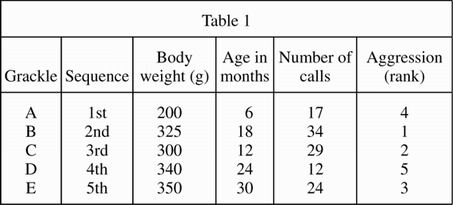
Experiment 2
The male grackles were placed back into the cage in the same sequence as in Experiment 1. The results of all aggressive encounters (number of calls) between pairs of birds were recorded. A bird was declared a "winner" if it forced the other bird, the "loser," to flee from the encounter. Table 2 shows the results of the interactions between the birds. There were no draws (ties) observed.
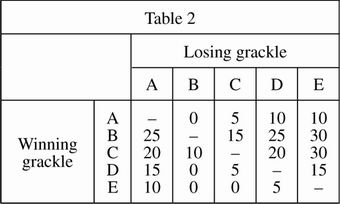
Table 3 summarizes the results of all the encounters for each bird.
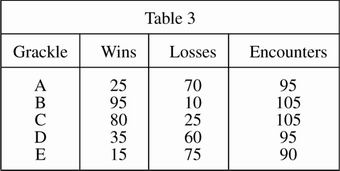
Which of the following generalizations about the relationship between body weight and rank is consistent with the experimental results?
The heaviest bird will be the most dominant.
The heaviest bird will be the most submissive.
Body weight has no effect on rank.
The lightest bird will be the most dominant.
It was suggested that the more dominant a male grackle is, the more likely it is to mate. Accordingly, one would predict, based on win-loss records, that the grackle with the highest likelihood of mating would be:
Grackle
Grackle
Grackle
Grackle
A sixth grackle, whose body weight was 330 grams and whose age was 24 months, was added to the experimental cage. It was observed that the bird called a total of 10 times during the experiment. Based on the results of Experiment 1, what would be the rank of the sixth grackle in terms of its aggressiveness?
3
4
5
6
According to the results of Experiments 1 and 2, which of the following factors is (are) related to the dominance of one male grackle over other males?
I. Age
II. Body weight
III. Number of calls
I and II only
I and III only
II only
III only
One can conclude from the results of Experiment 2 that Grackle C and Grackle A had a total of how many encounters with each other?
5
20
25
30
A criticism of this study is that the order that the grackles were placed in the cage may have affected the aggressiveness of each bird. The best way to refute this criticism would be to:
randomize the order before starting the experiments.
repeat the experiments several times with different orders each time.
place the birds in the cage in order of their age.
place the birds in the cage in order of their weight.
PASSAGE VII
In nature, different types of organisms often form symbiotic (mutually beneficial) relationships with each other. One such example of this is between certain types of fungi and plants; this relationship is known as a mycorrhiza. The association provides the fungus with food through access to sugars from photosynthesis in the plant. In return, the plant gains the use of the fungi's surface area to absorb mineral nutrients from the soil. It is believed that without the assistance of fungi, these plants would not be able to absorb crucial nutrients, including phosphates, from the soil. Two experiments were performed to study the effect that the plant-fungi relationship has on plant growth.
Experiment 1
For 6 weeks, several specimens of three different types of plants, selected from among four different types of plants, were grown in a greenhouse. The average growth in inches of each type of plant was recorded every two weeks. The soil used for the plants was treated to remove any trace of fungi to establish expected growth without the plant-fungi association. The results are shown in Table 1.
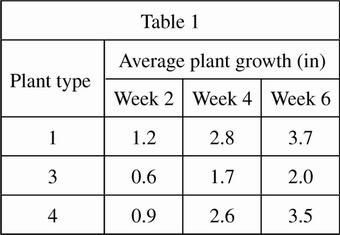
Experiment 2
In this experiment, several specimens of four different types of plants were grown in a greenhouse for six weeks, and the average growth in inches of each type of plant was recorded every two weeks. This time, however, untreated soil that contained fungi was used. The results are shown in Table 2.
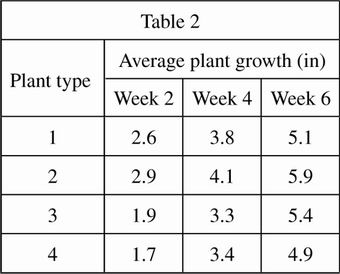
Information on the plant types used is given in Table 3.
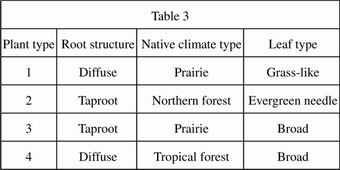
The results of Experiment 1 indicate that during what time frame did all of the plant types studied experience the greatest increase in growth rate?
0-2 weeks
2-4 weeks
4-6 weeks
Cannot be determined from the given information.
A plant from which climate type was NOT studied in Experiment 1?
Prairie
Tropical forest
Northern forest
All climate types were studied in Experiment 1.
Based on the results of Experiment 1, which plant type experienced the most total growth between Week 2 and Week 6?
Plant Type 1
Plant Type 3
Plant Type 4
Each plant type experienced the same total growth.
Based on the experiments, on the growth of which plant type did the presence of fungi in the soil have the greatest effect?
Plant Type 1
Plant Type 3
Plant Type 4
The fungi had the exact same effect on all plant types
Based on the results of Experiments 1 and 2, which of the following statements is most accurate?
The presence of fungi has little or no impact on plant growth.
Removing fungi from soil can help to increase growth in some plants.
The presence of certain fungi in the soil increases plant growth.
Fungi cannot survive in local greenhouses.
1 mã đề 12 câu hỏi
1 mã đề 24 câu hỏi
1 mã đề 26 câu hỏi
1 mã đề 12 câu hỏi
1 mã đề 24 câu hỏi
